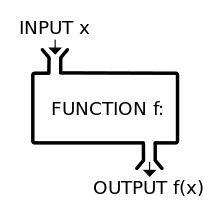Functions in Python: Difference between revisions
| Line 48: | Line 48: | ||
== Some decent videos about functions in Python == | == Some decent videos about functions in Python == | ||
In the video below, the programmer uses a different IDE than we do (we use canopy). The programmer also uses [[tests]] in this video, which we haven't covered yet. | In the video below, the programmer uses a different IDE than we do (we use canopy). The programmer also uses [[tests]] in this video, which we haven't covered yet. The video on the right is pretty good example of what a function is. | ||
<html> | <html> | ||
Revision as of 20:14, 10 April 2016

Introduction
In programming, a named section of a program that performs a specific task. In this sense, a function is a type of procedure or routine. Some programming languages make a distinction between a function, which returns a value, and a procedure, which performs some operation but does not return a value.
Most programming languages come with a prewritten set of functions that are kept in a library. You can also write your own functions to perform specialized tasks. [2]
We use function so we don't need to repeat ourselves.
Example of a function
#
# this is a simple function
#
def welcome(name):
if name == "Alisher":
likes_hamburgers ="yes"
else:
likes_hamburgers="no"
return likes_hamburgers
print welcome("Bill")
print welcome("Alisher")
print welcome("foo")
Another classic example of a function
#
# this is a simple function
#
def calculator(number1, number2):
answer = number1 + number2
return answer
print calculator(12,43)
print calculator(91,673)
print calculator(1,3)
print calculator(87,1098)
Some decent videos about functions in Python
In the video below, the programmer uses a different IDE than we do (we use canopy). The programmer also uses tests in this video, which we haven't covered yet. The video on the right is pretty good example of what a function is.